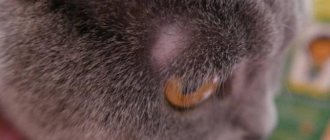If swelling of a cat's paw is observed, this may be a symptom of a traumatic injury, circulatory problems due to pinching of blood vessels during play or veterinary procedures. Swelling of the front or hind limbs also occurs due to arthritis, osteomyelitis, osteochondrodystrophy, and tumors. The owner needs to know how to provide first aid to the pet and urgently take it to the veterinary clinic, where the doctor will prescribe treatment.
According to veterinarian statistics, pets under 5 years of age are most susceptible to injury due to excessive curiosity, as well as older cats who have reduced resistance to microbes, which leads to inflammatory processes in their paws.
Causes of swelling and symptoms
Swelling of a limb in an animal does not just happen. This is usually a consequence of an infectious agent that causes inflammation and swelling. Causes of swelling:
- Damage. Cats are often injured. The damage affects a blood or lymph vessel, which leads to the release of a liquid component into the space between the cells. Blood or lymph permeates the soft tissues, causing them to swell. Germs enter through the wound. This can be detected if the cat's paw is swollen and festering. A tumor with pus does not go away on its own. She is hot and flushed to the touch. There is lameness on the damaged paw and swelling. If the pad was injured, then inflammation develops in it.
- Diseases of internal organs. The formation of edema is affected by the work of the urinary system, in particular the kidneys, or the cardiovascular system. In cases of kidney failure or heart disease, swelling affects the hind legs. Swelling begins in the paw pads, and as the disease progresses, it spreads to the entire limb.
- Joint diseases (arthritis, bursitis, tendonitis). The cause of these pathologies is the development of an inflammatory reaction in the joint and nearby tissues, for example, in the periarticular bursa or tendons. Symptoms: asymmetrical swelling, immobility, stiffness. Diseases more often affect older animals. Sometimes inflammation is caused by degenerative changes (arthrosis).
- Severe allergic reaction. This reason is considered the most common. The main factor causing allergies is the ingestion of toxic substances from an insect bite. The reaction causes extensive swelling and pain in the paw.
- Vascular diseases. Venous insufficiency is the main cause of regular paw swelling. The condition is dangerous due to blockage of the vessel, which will lead to the formation of necrotic areas and loss of limb.
- Lymphadenitis. Inflammation of the axillary lymph node is the main reason why a cat's front paw is swollen. An additional symptom is an enlarged, painful lymph node.
- Oncology. A malignant neoplasm of the mammary gland causes swelling of the paw on the side where the affected area is located. The tumor leads to compression of blood vessels and accumulation of lymph.
If you notice the first symptoms of a persistent tumor, it is recommended to immediately show your pet to a veterinarian.
The mechanism of edema
Speaking about the mechanism of edema, first of all, it is worth noting that there are two reasons for the pathological accumulation of fluid in tissues:
- Increased pressure in small vessels.
- Changes in the amount of proteins in plasma (the liquid component of blood) and increased permeability of vascular walls due to inflammatory processes, toxin poisoning, and disorders of nervous activity.
Moreover, the fluid that accumulates in the tissues can also be different. So, the following can lead to swelling:
- Blood;
- Lymph;
- Pus;
And the swelling itself can be:
- Limited (localized), covering small areas, and general (generalized), covering large areas;
- Symmetrical and asymmetrical (in this case, for example, the paw may swell).
What to do before visiting a doctor?
Once swelling is detected, the limb must be examined. The presence of a wound or damage will make the task easier. This immediately indicates the cause of the swelling. In this situation, you can cope on your own if there is no suppuration. Stages of assistance:
- wash the wound with an antiseptic (Chlorhexidine, hydrogen peroxide solution);
- treat the area around the injury with iodine, and in case of severe swelling - with alcohol;
- apply a bandage soaked in Ichthyol and Levomekol.
It is recommended to change the bandage once a day; when removed, the wound is washed again with an antiseptic. If there is no improvement or the situation worsens, then only a veterinarian can help. It is necessary to go to the clinic even if there are no injuries, since the cause of the pathology in this situation can only be determined by a professional. Before visiting the veterinarian, provide your pet with constant attention and rest.
Why is it important to find “your” doctor?
Unfortunately, sometimes the cause of swelling of a cat's paw can be a completely ordinary visit to the veterinarian. The first time I encountered such a situation was when my friend was preparing her Sphynx to move to a distant country. By all indications, the cat was absolutely healthy, but the rules required some kind of special blood test. At the veterinary clinic, blood from the vein was taken for analysis without any problems and a pressure bandage was applied to the injured paw to prevent the formation of a hematoma. Everything was done according to the rules, but they forgot to warn the owner that the bandage needed to be removed in about an hour. And my conscientious friend, deciding that it was better to be safe than sorry, left her paw wrapped until the morning (it was in the evening). And early in the morning it turned out that the long-suffering cat’s limb was twice as thick as it was the day before. Fortunately, nothing irreparable happened: it did not lead to tissue necrosis, the paw remained warm and retained sensitivity. So periodic massage and a loose bandage of alcohol-soaked gauze (recommended by another veterinarian) reduced the swelling by lunchtime. The second case directly affected my pet: during the drip administration of vitamins, a poorly secured catheter moved, and the drug went under the skin (instead of a vein). The paw was swollen, any touch to it caused pain, the baby refused to eat. A repeat visit to the veterinarian and a tight bandage with magnesium sulfate applied for an hour and a half corrected the situation. And this time, fortunately, there were also no serious consequences (in the form of an abscess, for example). As it turns out, such cases happen periodically. What can you do: cats are far from the calmest and most obedient patients. However, whatever you say, the doctor’s qualifications also play an important role. Therefore, do not be lazy to make inquiries and find a truly good specialist for your pet (if you value his health, of course). Believe me: a visit to the veterinary clinic closest to your home is not always the right step.
Video: swelling of a cat's paw after incorrect catheter installation
Swelling of cat limbs is many-sided and varied, as are the causes that cause them. Even if you want, you are unlikely to be able to protect your active and curious pet from all potential dangers, and that’s okay. The main thing is that you are a loving, caring and attentive owner for your cat. And then the swelling of your cat’s paw, which you notice in time, will most likely help solve or prevent serious health problems for your pet.
Cats have always been considered unpretentious and hardy, but even they have weaknesses. A cat's paw is made up of soft and smooth pads, and it is very easy to injure its tissues with sharp objects. And if the limb is swollen, you should be concerned and consult a veterinarian.
Edema and edema are different
Swelling of cat limbs is many-sided and varied, as are the causes that cause them. A cat's paws may swell:
- in a separate relatively small area - with the so-called localized (local or limited, otherwise local) edema;
- over a large area or over the entire surface of the limb - with generalized (or general) edema.
Often the swelling occurs on one paw of the animal (asymmetrical/asymmetrical edema), less often - on two at once (symmetrical edema).
Photo gallery: types of paw edema in cats
Localized swelling occurs in a relatively small, localized area of the cat's paw
Generalized edema covers a significant area of the animal's limb
Symmetrical swelling appears on both legs of the pet at once
Moreover, in most cases, just by the appearance and location of the swollen areas, one can assume what caused their appearance. Moreover, swelling of the paws characteristically affects the behavior of the animal and is often accompanied by additional specific symptoms.
Treatment
Providing assistance in case of injury has already been sorted out. For treatment in other cases, it is necessary to identify the cause, which is what the veterinarian does. After making a diagnosis, he prescribes the necessary procedures:
- Joint diseases - adding products to the diet that include chondroitin and glucosamine; taking antibacterial drugs (Sinulox, Ceftriaxone); pain relief (Buprenorphine, Meloxicam).
- Allergies – eliminating the allergen from the pet’s life; Diphenhydramine injection to improve the condition; antihistamines (Bicarfen, Diazolin, Suprastin, Tavegil).
- If the cause is a disease of the internal organs, then treatment is carried out depending on the identified pathology.
- For problems with blood vessels, regular massage of the affected limb is performed. If the problem is thrombosis, then surgery is performed. For preventive purposes, the doctor will prescribe medications to dissolve blood clots.
- Suppuration (abscess) - opening the tumor, removing pus, treating with an antiseptic, installing drainage. Antibiotics are prescribed if necessary.
- Cancerous tumor - surgical removal, chemotherapy or radiation followed by restorative therapy.
If your cat's paw is swollen, you should not hesitate to treat it. Extensive inflammation is dangerous due to blood poisoning and necrosis, which often leads to the death of the animal.
Chronic diseases of internal organs
If a cat's back paw is swollen, but he does not feel pain (does not limp, does not moan, does not show any signs of pain and does not have a temperature), then the animal needs to be fully diagnosed. A characteristic sign of kidney, liver, or heart disease is swelling only on the hind legs, with no other symptoms.
A limb can also swell due to diseases of the internal organs: the process of inflammation begins from the tips of the paws, and gradually the swelling spreads higher. Be sure to get your pet examined; timely therapy will help prolong his life.
Joint inflammation
Older animals, animals with injuries, and those lacking vitamins and minerals may develop arthritis. The disease is accompanied not only by pain (which the cat cannot talk about), but also by asymmetrical swelling: the animal becomes limited in its movements, its flexibility and dexterity are not worth talking about.
Only a veterinarian can diagnose arthritis. Treatment is carried out in a course, the following drugs can be prescribed:
- "Meloxicam" - relieves pain syndromes.
- Antibacterial drugs are mandatory because they can quickly relieve inflammation and reduce the severity of pain.
- "Sinulox" is one of the safest drugs for animals, as it is non-toxic.
- Chondroprotectors - help restore damaged joint tissue.
Diagnostic methods
Regardless of the cause of the edema, it is always necessary to carry out diagnostics, which are done in an inpatient setting. This should be done by a doctor, after an examination he will be able to make an accurate diagnosis. Diagnostics helps to find out what caused the swelling, especially if it is impossible to identify visible damage and recognize the causes of the symptoms. Primary diagnosis includes a standard external examination of the limb and the animal as a whole.
X-ray of paws
After an external examination, blood and other body fluids are tested and, if necessary, a cardiogram is performed to evaluate the functioning of the heart. To assess damage to a limb, your doctor will perform an MRI or X-ray to check for fractures, dislocations, and bruises. If the diagnosis is confirmed, the swollen limb is treated and treatment is prescribed.
First aid for a swollen paw
When it is noticed that a cat's paw is swollen, it should be examined immediately. If it is discovered that the disorder is due to her being injured, then you can try to avoid visiting the veterinary clinic, but only if there is no severe suppuration. The algorithm of actions for treatment should be as follows:
- washing the wound with hydrogen peroxide or chlorhexidine;
- treating the skin around the wound with iodine - if the limb is particularly swollen, then iodine can be dangerous and is replaced with alcohol;
- applying a bandage to the wound with a mixture of ichthyol ointment and levomekol ointment.
Allergic reaction
If a cat's paw is swollen after a walk, most likely it is an acute manifestation of an allergy. This may be a consequence of poisons and toxins entering the animal’s body, or may also be the result of insect bites. Allergies are often accompanied by increased watery eyes and a runny nose, and the swollen area itself is often cold to the touch.
If the issue is an allergy, then quickly take the animal to the veterinarian so that he can prescribe and use a fast-acting antihistamine. You may need an injection with Diphenhydramine.
Cancer tumor
No, swelling on the paw is not the tumor itself, it is only a consequence of it. If an animal develops mammary cancer, it begins to interfere with the circulation of lymph in the vessels and thereby causes its stagnation.
The disease is detected through tests and x-rays. If a diagnosis is made, they may offer surgical intervention that will help prolong the pet’s life. Next, a course of medications is prescribed.
If a cat has a swollen paw, only a doctor can tell you what to do in this situation after examining the animal. We talked about the possible causes of edema, diagnostic methods, and possible treatment. And if your animal's limbs become swollen, you should definitely take him to the vet. It is important to remember that you cannot self-medicate, because the health of your beloved pet depends on the correctness of the measures taken.
Tumors by location
It is possible to guess the origin of the tumor based on its location, but this diagnostic method does not always work.
But there are still pathologies that most often appear on the front/hind legs.
On the front paw
Most often, tumors develop on the front paw for the following reasons (taking into account the possibility of the appearance of tumors):
- Injuries, including fractures.
- It is in the soft tissues of the front paws that splinters are most often found. They can cause both traumatic swelling and abscesses. The latter develop due to pathogenic microflora entering the wound canal. In the latter case, the tissues swell, become hot and thicken. As the abscess matures, it softens.
- Possible formation of hematomas. Due to strong impacts or other traumatic influences, blood vessels may be damaged. The blood coming out of them accumulates in the subcutaneous tissue and under the skin. In the first days the swelling is soft, after a few days it thickens and hardens.
We suggest you read: How to stop a cat from tearing wallpaper and furniture, the main reasons and what to do
On the hind leg
Tumors on the hind leg develop due to:
- The hind limbs very often become swollen and swollen in diseases of the heart and kidneys. The swelling is cold and dense.
- In addition, swelling of allergic origin often develops in the hind legs.
- Sometimes this is how myositis (muscle inflammation) manifests itself. These cases are characterized by severe pain.
All described pathologies can develop with equal probability on all paws.
Between the fingers
A tumor between the fingers is a common consequence of fungal pathologies. Malassezia is especially famous for this. This pathology, caused by yeast, is not typical for cats, but in practice it still occurs. Characterized by the following symptoms:
- Strange, lumpy growths appear in the spaces between the fingers.
- They are soft and “cheesy” to the touch.
- A strange, moldy, musty smell emanates from the paws of a sick animal.
Tumors in the interdigital spaces can be the result of allergies and abscesses due to foreign bodies entering the soft tissues. In the first case, the pathology is accompanied by severe itching, in the second, severe pain develops.
On the joint
A swelling or large lump on a joint is a sure sign that an animal’s limb is affected by arthritis, bursitis, arthrosis or other joint pathology.
All these diseases are accompanied by a pronounced pain reaction and severe lameness of the animal. In all cases, the tumor does not appear suddenly, but over a fairly long period of time. Older cats are most often affected.
How to treat if a cat has a swollen paw
When a cat's paw is swollen, it is necessary to find the cause of this pathological phenomenon. Swelling of the paws does not appear on its own, and therefore it is important to provide the animal with the necessary help. The paw swells due to the accumulation of pus, blood or lymph in the intercellular space of its tissues. This phenomenon is caused by diseases or mechanical injuries. If a cat has mechanical damage as a result of a cut, bite, embedded splinter, dislocation or fracture, it is necessary to fix the paw and apply cold. Subsequent actions must be entrusted to a specialist. The veterinarian will determine the cause of the pathology visually or using instrumental studies (X-rays, etc.).
The specialist will straighten the dislocation, apply stitches, bandage it, and prescribe antibiotics. Further actions of the owner are aimed at fulfilling the doctor’s orders.
In some cases, an allergic reaction develops to an insect bite. Only one paw is affected, mainly the front one, swelling develops at the site of the bite, and the local temperature rises. If the pathological symptom does not go away within a few hours, veterinary attention will be required. The veterinarian will administer an antihistamine and the swelling will subside.
Arthritis develops mainly in older pets. The reason is a metabolic disorder due to an unbalanced diet. Obesity and chronic diseases develop. One or both hip joints are swollen, painful, hot, and the skin is tense.
The treatment is long-term, complex, and develops in the following areas:
- drug therapy using anti-inflammatory drugs and antibiotics;
- therapeutic diet using ready-made food for cats with joint diseases;
- physiotherapy.
One of the pathological symptoms of heart, liver, and kidney failure is symmetrical swelling of the paws. They suffer. mainly older pets. The disease is incurable. Symptomatic treatment allows you to maintain your pet’s well-being at a satisfactory level.
Lymphadenitis is inflammation of the lymph nodes. Develops as a complication of an infectious disease. The lymph nodes are enlarged and can be detected by palpation. The swelling extends only to the front legs and is accompanied by lameness. If the underlying disease is treated, the lymph nodes will shrink and the swelling will subside.
Most often, cancer affects the mammary glands of an older cat. The swelling extends to the hind legs. Animals whose owners abuse hormonal contraceptives become ill. Treatment is symptomatic, supportive, the prognosis is unfavorable.
Causes
Swelling of the limb (edema) occurs because fluid accumulates in the tissues, in their intercellular space: lymph, blood or pus.
The cause of swollen paws can be various circumstances. To determine them, you need to carefully observe your pet. Swelling does not occur on its own. Additional signs and symptoms will certainly be present.
- Limb injuries (fracture, bruise, dislocation, sprain, cut, laceration) are one of the common causes of edema. In these cases, you can additionally notice the following symptoms: the animal limps and does not lean on its paw; violation of the integrity of the skin - when soft tissues are damaged to the point of bleeding by sharp objects; suppuration, redness at the site of injury; increase in body temperature. The pad on a cat's paw is covered with delicate skin. Therefore, it is often she who can get injured and swell.
- Allergy in its severe manifestation is another reason why a paw may swell. Basically, an acute allergic reaction occurs when poison enters the body from an insect bite or after contact with chemicals. As a rule, there is no pain or it is not too noticeable, the area of edema is cold. Allergy is not accompanied by swelling alone. May appear: itching; lacrimation, excessive salivation; runny nose.
- Fungal infection (mycosis) can also cause the paw to swell. Associated symptoms can help diagnose a fungal infection, such as: peeling of the skin, for example, on the pad; unpleasant odor; cat dandruff. The fungus develops when the animal’s immune system is weakened. Basically, those pets that often walk outside are susceptible to this.
- Inflammation of the joints (arthritis) is accompanied by local asymmetrical swelling in the limbs. Joint diseases usually develop in older cats, limit their mobility, and cause pain.
- A recently born kitten may develop a disease such as hyperparathyroidism due to disruption of hormone production. Symptoms may include swelling of the limbs, lameness in the front or back legs due to muscle pain.
- In case of venous insufficiency and diseases accompanied by blockage of blood vessels (thrombosis, thrombophlebitis), a distinctive feature is the regular occurrence of asymmetrical edema.
- Kidney diseases and accompanying renal failure, as well as diseases of other internal organs (heart, liver) also provoke the formation of edema. A characteristic sign is swelling of only the hind limbs. Such swelling begins from the tips of the paws, gradually spreading upward. There is no fever or pain.
- Lymphadenitis is inflammation of the lymph nodes. It occurs with pain and severe swelling of the paws if the axillary lymph nodes are inflamed.
- The most serious reason that a cat has a swollen paw is mammary cancer. Swelling of the limb in this case occurs because the malignant formation blocks the circulation of lymph in the vessel, causing it to stagnate. Only the paw on the side of which the mammary gland lesion has developed becomes swollen.
Injury
Cats are inquisitive creatures, they can get various injuries: lacerations, bruises, dislocations, fractures, sprains, cuts. Not only the paw itself, but also its pad can be damaged, so the animal’s limb should be examined in detail.
If a cat's paw is swollen due to an injury, and he is limping, does not support himself, or can barely hold the sore limb elevated, first check the integrity of the skin to exclude lacerated purulent wounds. If there are any, you can provide first aid yourself: wash the wound, clean the accumulation of blood and pus, treat it with an antiseptic, and bandage it. Next, you need to contact a veterinarian: you may need a course of antibiotics to prevent infection.
If there are no lacerations, then you will need to take the cat for an x-ray to determine the presence or absence of a fracture. If necessary, the veterinarian will apply a splint.
To ease your pet's condition while you wait for the doctor, you can apply a cold compress.
The cat is swollen
This article provides general information that describes typical situations that veterinarians have to deal with in practice, and also provides explanations for such problems.
The reason why the cheek and gums may swell is tartar, accumulation of food debris or hair. All this leads to the development of the inflammatory process. Treatment involves daily treatment of the oral cavity, as well as gum massage. If necessary, the doctor may prescribe antibiotics.
Try dropping hydrogen peroxide into your eye, or soak a swab in it and gently blot your eye. Tetracycline ointment can be placed under the eyelid. If the animal behaves calmly, try applying something cold, this way the swelling and inflammation will be relieved.
If abrasions or wounds are visible, they should be treated with hydrogen peroxide and also smeared with Levomekol ointment. In addition, it could be an abscess; in this case, only a doctor can help.
There can be many reasons why cats' lips swell - new food, a bite, injury, the development of an allergic reaction, some kind of viral infection. It is simply unreasonable to recommend any action in this case. Treatment primarily depends on what exactly became the provoking factor, so for the sake of your pet’s health you need to visit the hospital.
There are several diseases that can cause the upper eyelid to swell. Blepharitis - development is provoked by infections, as well as mechanical injuries. Development of allergies - in this case, accompanying symptoms may be present, for example, a runny nose. Injury – a foreign object entering the eye can lead to swelling. Damage from bacteria or infections.
If you notice such a problem, you need to carefully examine the paw: are there any foreign objects, integrity. Gently feel and see if the cat is in pain. Take something cold and apply it to the paw; the limb must be immobilized. The next necessary step is to see a doctor.
We suggest you read: Treatment and prevention of papilloma in cats. Papillomas in cats: causes, diagnosis and treatment of the disease
The pads on the paws can swell for various reasons - inflammation, injury, tumor. In order for you to be diagnosed, you need to take the animal to a veterinarian.
The muzzle on one side may swell for the following reasons: - Phlegmoma is a purulent inflammation. — Development of an allergic reaction. - Poisoning.
- Some kind of hematoma.
— Myositis is a condition in which muscle inflammation occurs.
Treatment depends on the cause of the swelling, and may require applying heat, diphenhydramine, or corticosteroids or anti-inflammatory drugs.
The mammary gland may become swollen due to the development of a disease such as mastitis. The thing is that pathogenic microorganisms begin to settle there. You can take some measures yourself only at the first stage of the development of the disease. You can express milk manually, but it is unlikely that your cat will allow you to do this. You cannot massage or use anything to warm you.
Gingivitis is a disease in which the gums become inflamed and swollen. At the first stage of development it may be asymptomatic. The cause of the tumor can also be mechanical damage. The first thing you need to do is brush your teeth. The oral cavity should be treated with decoctions based on medicinal herbs - chamomile, oak bark.
The cause of the tumor may be external otitis media. The disease is of two types - acute and chronic. Try treating your ear with silver nitrate. Iodoform ether can be instilled into the ears themselves.
In order to remove the swelling after the catheter, it is necessary to lubricate the paw with heparin ointment and be sure to ensure that the cat does not lick it off.
The cause of the tumor may be bone injury or an allergic reaction. First of all, apply something cold, this can relieve pain and reduce swelling. The next action should be to go to the clinic.
When a cat's paw is swollen, it is necessary to find the cause of this pathological phenomenon. Swelling of the paws does not appear on its own, and therefore it is important to provide the animal with the necessary help.
The paw swells due to the accumulation of pus, blood or lymph in the intercellular space of its tissues. This phenomenon is caused by diseases or mechanical injuries. Depending on what caused the cat’s paw swelling, the necessary treatment is carried out. The swelling itself will go away only if its cause is a bruise. More often it affects the hind legs.
Many pet owners do not have an accurate idea of what diseases their pets may suffer from. The most common diseases are fairly easy to recognize, but there are a number of diseases that are rare and therefore baffle pet owners. One of these diseases is feline plasmacytic pododermatitis.
This disease occurs exclusively in cats and affects the pads of their paws.
This passes painlessly, the pads seem swollen and enlarged, but the general condition of the animal is satisfactory, most often without changes, so pododermatitis in the initial stages can go unnoticed, especially if the animal leads a free lifestyle and has the opportunity to walk freely, or if there are several cats .
Some animals may experience lymphadenopathy - enlarged lymph nodes, while others do not react at all to the development of pododermatitis. The toe pads are very rarely affected; most often the main pad of the foot or part of it is affected.
Dermatitis can occur on one paw, on several paws, or be diagnosed on all four paws. The stages of the disease can be completely different, from barely noticeable swelling to severe swelling with complications in the form of a secondary infection.
With the long-term development of the disease, the pads become greatly enlarged and inflamed, and if the integument is damaged and infection occurs, they can fester, turn blue and become covered with purulent crusts.
As inflammation develops, the cat may limp on one leg, or if more limbs are affected, it will be noticeable that it is inconvenient and uncomfortable for him to move, the animal will try to lie down more.
All cats are equally susceptible to this disease - kittens, young, old, purebred and crossbreeds, domestic and stray. It doesn’t matter if it’s a cat or a female cat—any animal can get hurt.
At the moment there is no exact data on the cause of the disease. Many veterinarians believe that plasmacytic type pododermatitis is a peculiar reaction of the body to some external or internal influences.
It is believed that this disease occurs as a response of the immune system to various factors, that is, dermatitis itself is a skin reaction, a symptom of a problem that has arisen due to the inappropriate behavior of the animal’s immune system. Perhaps this explains the cases of spontaneous cure of the disease.











